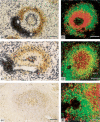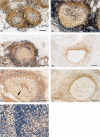CD27+ B cells in human lymphatic organs: re-evaluating the splenic marginal zone
- PMID: 16313357
- PMCID: PMC1802440
- DOI: 10.1111/j.1365-2567.2005.02242.x
CD27+ B cells in human lymphatic organs: re-evaluating the splenic marginal zone
Abstract
The marginal zone of human spleens is regarded as an organ-specific region harbouring sessile memory B cells. This opinion has arisen by extrapolating from results obtained in mice and rats. Detection of CD27(+) B cells in situ now revealed similarities among the most superficial region of B-cell follicles in human spleens, reactive lymph nodes, inflamed appendices, tonsils and terminal ilea. The follicular surface in these organs consists of small naïve immunoglobulin D (IgD)(+) CD27(-) B cells predominating in an inner area and larger IgD(+/-) CD27(+) B cells prevailing in a more superficial position. CD27(+) B cells may, however, also occupy the entire follicular periphery around the germinal centre. Together with additional peculiarities this distribution indicates a fundamental microanatomical difference among the human and rodent splenic white pulp. We hypothesize that the follicular periphery represents a recirculation compartment both for naïve and memory/natural reactive B cells in all human secondary lymphatic organs. This assumption implies a difference in recirculation behaviour among human and rodent B memory cells.
Figures



References
-
- MacLennan ICM, Liu Y-J. Marginal zone B cells respond both to polysaccharide antigens and protein antigens. Res Immunol. 1991;142:346–51. - PubMed
-
- Martin F, Kearney JF. Marginal zone B cells. Nature Rev Immunol. 2002;2:323–35. - PubMed
-
- Kanayama N, Cascalho M, Ohmori H. Analysis of marginal zone B cell development in the mouse with limited B cell diversity. role of the antigen receptor signals in the recruitment of B cells to the marginal zone. J Immunol. 2005;174:1438–45. - PubMed
-
- Kumararatne DS, Bazin H, MacLennan ICM. Marginal zones: the major B cell compartment of rat spleens. Eur J Immunol. 1981;11:858–64. - PubMed
-
- Kraal G. Cells in the marginal zone of the spleen. Int Rev Cytol. 1992;132:31–74. - PubMed
Publication types
MeSH terms
Substances
LinkOut - more resources
Full Text Sources
Research Materials

